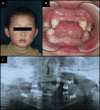Genetic Basis of Nonsyndromic and Syndromic Tooth Agenesis
- PMID: 27895972
- PMCID: PMC5123891
- DOI: 10.1055/s-0036-1592421
Genetic Basis of Nonsyndromic and Syndromic Tooth Agenesis
Abstract
Human dentition development is a long and complex process which involves a series of reciprocal and sequential interactions between the embryonic stomodeal epithelium and the underlying neural crest-derived mesenchyme. Despite environment disturbances, tooth development is predominantly genetically controlled. To date, more than 200 genes have been identified in tooth development. These genes implied in various signaling pathways such as the bone morphogenetic protein, fibroblast growth factor, sonic hedgehog homolog, ectodysplasin A, wingless-type MMTV integration site family (Wnt), and transform growth factor pathways. Mutations in any of these strictly balanced signaling cascades may cause arrested odontogenesis and/or other dental defects. This article aims to review current knowledge about the genetic mechanisms responsible for selective nonsyndromic tooth agenesis in humans and to present a detailed summary of syndromes with hypodontia as regular features and their causative genes.
Keywords: genes; hypodontia; oligodontia; tooth agenesis.
Figures


References
-
- Peters H, Balling R. Teeth. Where and how to make them. Trends Genet. 1999;15(2):59–65. - PubMed
-
- Line S RP. Molecular morphogenetic fields in the development of human dentition. J Theor Biol. 2001;211(1):67–75. - PubMed
-
- Matalova E, Fleischmannova J, Sharpe P T, Tucker A S. Tooth agenesis: from molecular genetics to molecular dentistry. J Dent Res. 2008;87(7):617–623. - PubMed
-
- Rølling S, Poulsen S. Agenesis of permanent teeth in 8138 Danish schoolchildren: prevalence and intra-oral distribution according to gender. Int J Paediatr Dent. 2009;19(3):172–175. - PubMed
-
- Vieira A R. Oral clefts and syndromic forms of tooth agenesis as models for genetics of isolated tooth agenesis. J Dent Res. 2003;82(3):162–165. - PubMed
Publication types
LinkOut - more resources
Full Text Sources
Other Literature Sources

